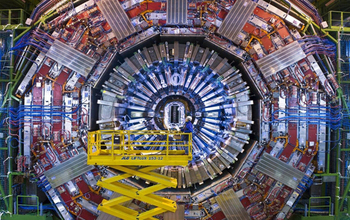Multimedia Gallery
First open-access collider data released
The Compact Muon Solenoid, a general-purpose detector, is one of the main detectors in the world’s largest particle accelerator, the Large Hadron Collider.
More about this image
A study by Jesse Thaler, an associate professor of physics at MIT and a long-time advocate for open access in particle physics, and colleagues demonstrates the scientific value of a move to publicly release 29 terabytes of information related to the Compact Muon Solenoid (CMS) experiment.
Released in November 2014, the data, recorded and processed throughout the year 2010, amounted to about 29 terabytes of information, yielded from 300 million individual collisions of high-energy protons within the CMS detector. The sharing of these data marked the first time any major particle collider experiment had released such an information cache to the general public.
"In our field of particle physics, there isn’t the tradition of making data public," says Thaler, who is a researcher in MIT's Laboratory for Nuclear Science. "To actually get data publicly with no other restrictions -- that’s unprecedented."
Groups at the Large Hadron Collider and other particle accelerators have kept proprietary hold over their data due to concern that such data could be misinterpreted by people who may not have a complete understanding of the physical detectors and how their various complex properties may influence the data produced.
Thaler says the reluctance to release data to the public was that you might have people claiming evidence for new physics when actually it was just a glitch in how the detector was operating. "I think it was believed that no one could come from the outside and do those corrections properly, and that some rogue analyst could claim existence of something that wasn’t really there," says Thaler.
"This is a resource that we now have, which is new in our field," Thaler adds. "I think there was a reluctance to try to dig into it, because it was hard. But our work here shows that we can understand in general how to use this open data, that it has scientific value, and that this can be a stepping stone to future analysis of more exotic possibilities."
To learn more about this research, see the MIT news story First open-access data from large collider confirm subatomic particle patterns. (Date image taken: 2014; date originally posted to NSF Multimedia Gallery: Nov. 15, 2017)
Credit: Image courtesy of CERN
Images and other media in the National Science Foundation Multimedia Gallery are available for use in print and electronic material by NSF employees, members of the media, university staff, teachers and the general public. All media in the gallery are intended for personal, educational and nonprofit/non-commercial use only.
Images credited to the National Science Foundation, a federal agency, are in the public domain. The images were created by employees of the United States Government as part of their official duties or prepared by contractors as "works for hire" for NSF. You may freely use NSF-credited images and, at your discretion, credit NSF with a "Courtesy: National Science Foundation" notation.
Additional information about general usage can be found in Conditions.
Also Available:
Download the high-resolution JPG version of the image. (427.7 KB)
Use your mouse to right-click (Mac users may need to Ctrl-click) the link above and choose the option that will save the file or target to your computer.

